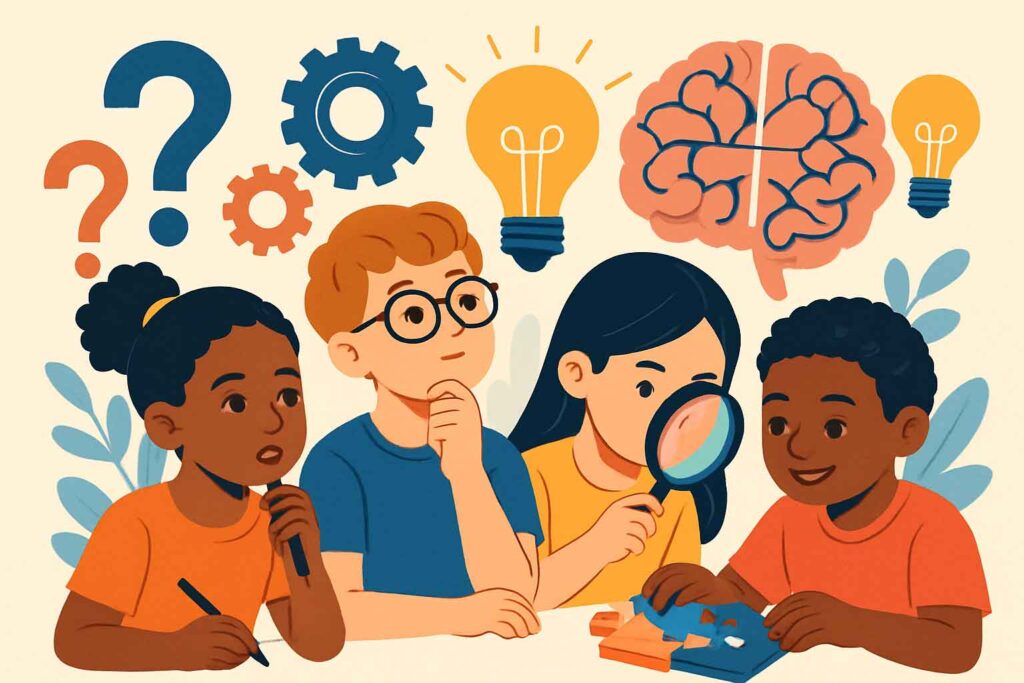Introduction
In an age of information overload and rapidly evolving challenges, the ability to think critically is no longer a luxury but a necessity. Critical thinking – the objective analysis and evaluation of information in order to form a judgment – empowers children to navigate complex situations, make informed decisions, and solve problems effectively. Far from simply memorizing facts, critical thinking involves questioning, analyzing, synthesizing, and evaluating information. This article will explore the importance of fostering critical thinking skills in children, its core components, and practical strategies for parents and teachers to nurture these vital abilities for lifelong success.
What is Critical Thinking?
Critical thinking is a higher-order thinking skill that goes beyond simple recall. It involves a set of cognitive processes that enable individuals to:
•Analyze: Break down information into its component parts to understand its structure and relationships.
•Evaluate: Assess the credibility, relevance, and accuracy of information and arguments.
•Interpret: Understand the meaning and significance of information.
•Infer: Draw logical conclusions based on evidence and reasoning.
•Explain: Clearly articulate the results of one’s reasoning.
•Self-Regulate: Monitor and correct one’s own thinking processes.
It’s about asking
questions, challenging assumptions, and seeking deeper understanding rather than passively accepting information.
Why Critical Thinking is Essential for Children
Cultivating critical thinking skills in children offers numerous benefits that extend across academic, personal, and professional domains:
1. Enhanced Problem-Solving Abilities
Critical thinkers are adept at identifying problems, analyzing their root causes, and developing effective solutions. This skill is invaluable in all aspects of life, from academic challenges to everyday dilemmas.
2. Improved Decision-Making
By learning to evaluate information and consider multiple perspectives, children can make more informed and responsible decisions, leading to better outcomes in their personal lives and future careers.
3. Greater Academic Success
Students who can think critically perform better in school. They can understand complex concepts, analyze texts, construct logical arguments, and excel in subjects that require analytical reasoning.
4. Protection Against Misinformation
In the digital age, children are constantly bombarded with information, much of which can be biased, inaccurate, or misleading. Critical thinking skills empower them to discern credible sources from unreliable ones, protecting them from manipulation and misinformation.
5. Fostering Creativity and Innovation
Critical thinking is not just about analysis; it’s also about generating new ideas and approaches. By questioning existing norms and exploring different possibilities, children can become more creative and innovative thinkers.
6. Active and Engaged Citizenship
Critical thinkers are more likely to be engaged and informed citizens. They can analyze social and political issues, participate in constructive dialogue, and contribute meaningfully to their communities.
Practical Strategies for Parents and Teachers
Fostering critical thinking is an ongoing process that can be integrated into daily interactions and learning experiences:
For Parents:
•Ask Open-Ended Questions: Instead of asking questions with simple yes/no answers, encourage your child to explain their reasoning. “Why do you think that happened?” “What are some different ways we could solve this?”
•Encourage Curiosity: Support your child’s natural curiosity by exploring their questions together. Visit museums, libraries, and engage in discussions about current events.
•Play Games that Promote Thinking: Board games, puzzles, and strategy games are excellent for developing problem-solving and critical thinking skills.
•Discuss Media Critically: Watch movies, read books, or browse online content together and discuss what’s presented. “Is this character’s decision fair?” “What’s the main message of this story?”
•Encourage Debate and Discussion: Create a safe space for your child to express their opinions and respectfully challenge others’ viewpoints. Teach them how to support their arguments with evidence.
•Allow for Mistakes: Let your child make mistakes and learn from them. Guide them through the process of analyzing what went wrong and how to improve next time.
For Teachers:
•Design Inquiry-Based Learning: Structure lessons around compelling questions that require students to investigate, research, and draw their own conclusions.
•Use Socratic Questioning: Employ questions that probe deeper understanding, challenge assumptions, and encourage students to think beyond surface-level answers.
•Promote Collaborative Learning: Group projects and discussions encourage students to consider diverse perspectives, negotiate ideas, and build shared understanding.
•Teach Source Evaluation: Explicitly teach students how to evaluate the credibility and bias of information sources, especially online.
•Incorporate Real-World Problems: Present students with authentic problems and challenges that require them to apply critical thinking skills to find solutions.
•Encourage Metacognition: Help students reflect on their own thinking processes. “How did you arrive at that answer?” “What strategies did you use?”
•Provide Opportunities for Debate and Argumentation: Create structured opportunities for students to engage in respectful debates, presenting evidence-based arguments.
Conclusion
Cultivating critical thinking skills in children is an investment in their future. By moving beyond rote memorization and embracing inquiry, analysis, and evaluation, we empower the next generation to become independent thinkers, effective problem-solvers, and engaged citizens capable of navigating the complexities of a rapidly changing world. As parents and educators, our role is to provide the tools, opportunities, and encouragement for children to develop these invaluable skills, ensuring they are not just learners, but critical thinkers for life.
